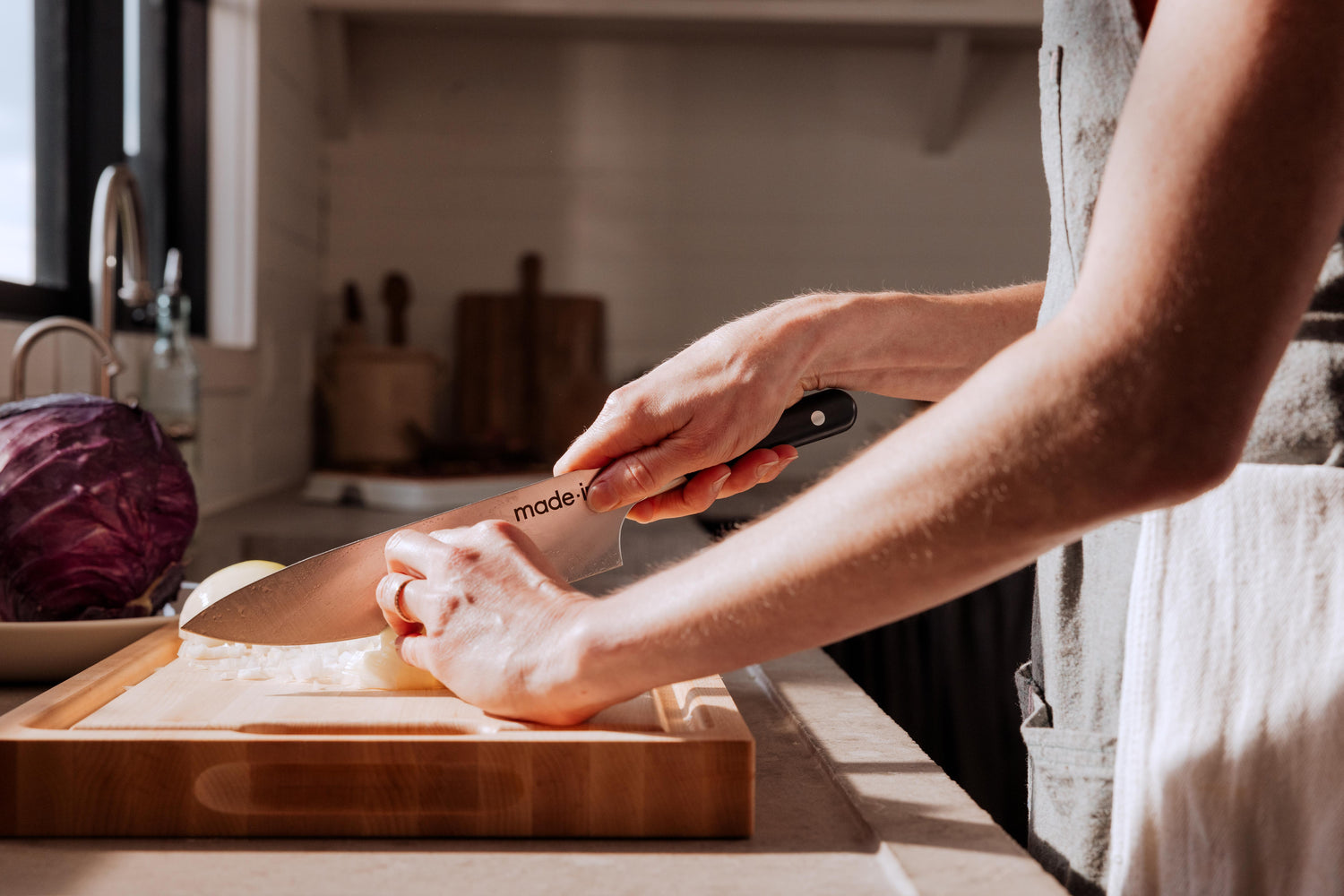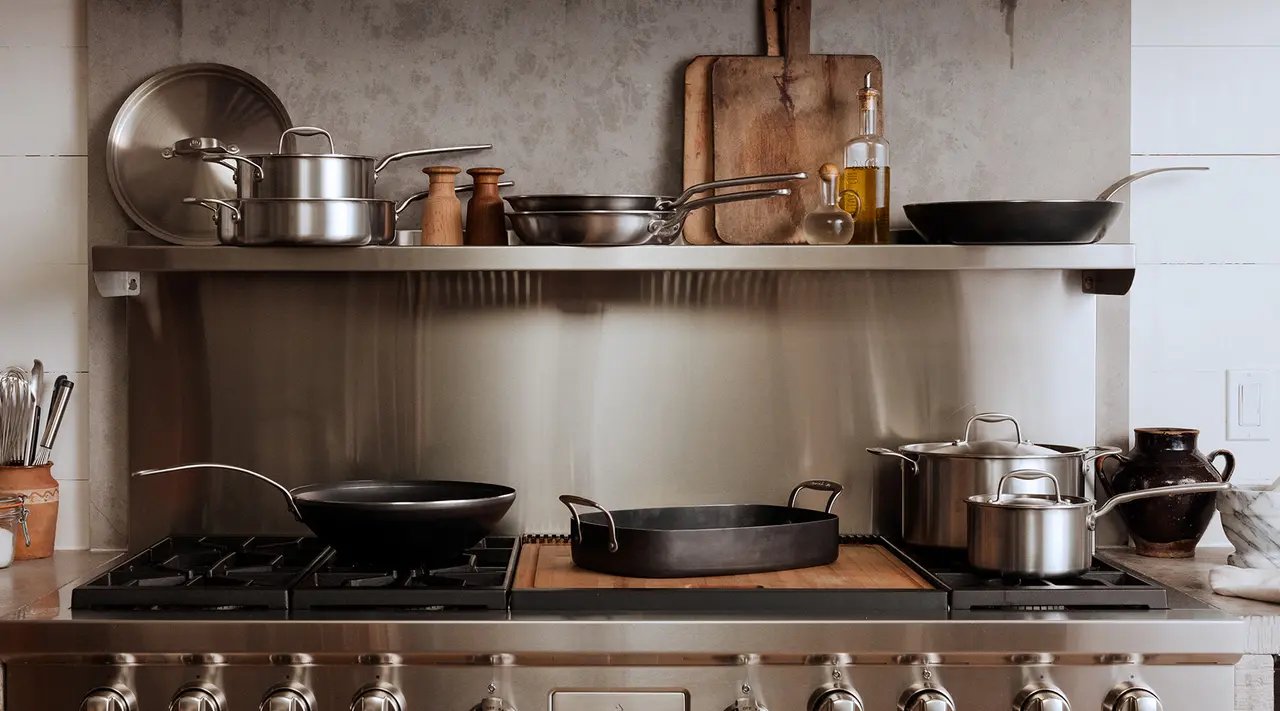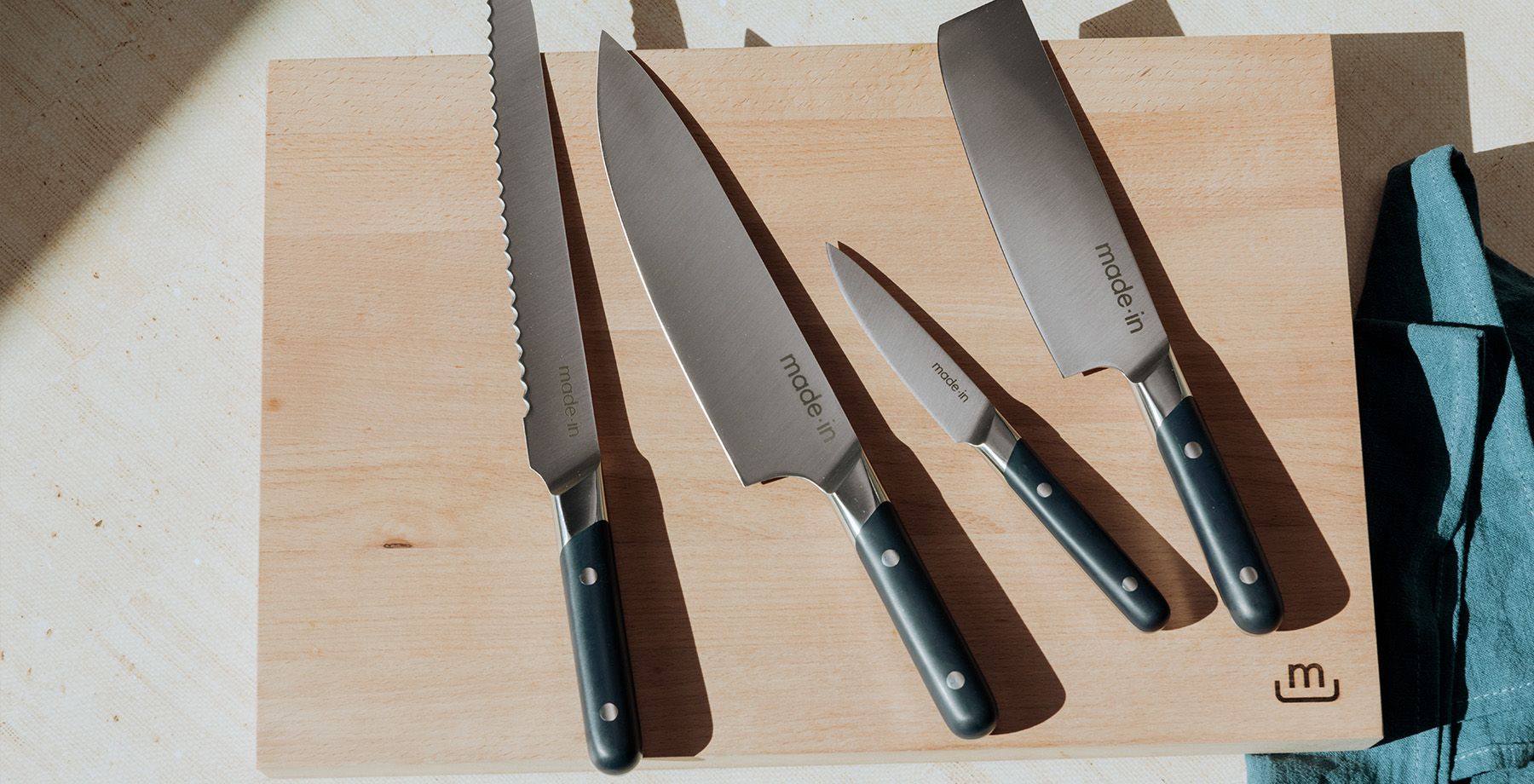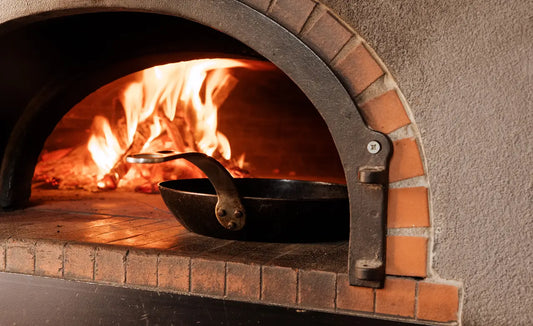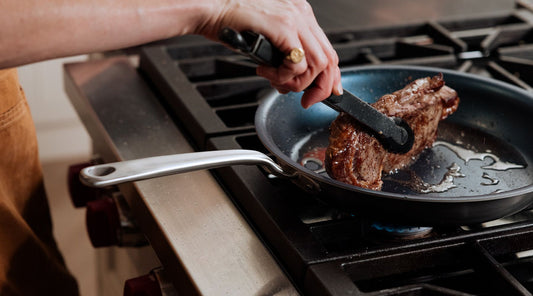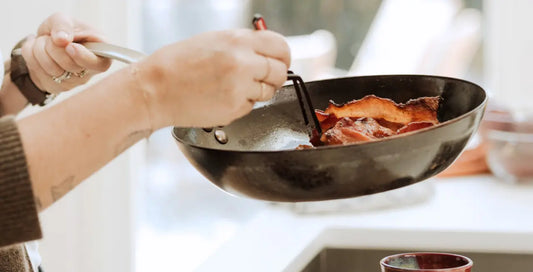Bread Knife
Uses: Slicing breads of all varieties, torting cake layers, or cutting a tomato without losing any juices.
Whether you need to slice a loaf of whole wheat bread, a baguette, fresh-baked sourdough, or an everything bagel, you should use a serrated bread knife. Not only is it designed with safety in mind, it’s also a universally praised must-have on any knife block, with additional uses beyond its namesake.
Unlike a chef knife, which is designed to chop tip-first, a bread knife is meant to be used in a back-and-forth sawing motion. That means a longer blade is better—the ideal length for a home chef’s bread knife is 9 inches.
The serrated blade allows the knife to tear through the crust of a loaf without crushing it, preserving its texture. In some cases, it does the same for produce—it’s our knife of choice for cutting tomatoes. Compare the clean, even slices you get with a bread knife to those achieved with a chef’s knife, which requires you to press straight down and risk mashing bread and soft vegetables alike.
Boning Knife
True to its name, boning knives are best for deboning and other related tasks like separating cartilage and fat from meat (and can also be used for other tasks like peeling or sectioning fruit and vegetables). Resembling a long, skinny chef's knife, the blade is typically more flexible than other knives in your block—closer to a fillet knife than a rigid chef knife.
Ours features a 6" blade, which we've found to be the ideal length for the precision needed for deboning and butchery while never leaning toward the unwieldy.
Chef Knife
Uses: Almost any kitchen task, from breaking down chicken wings to slicing an onion. Expect to use this blade for around 80% of all cutting tasks.
The carpenter has their hammer. The painter has their brush. The chef has their chef knife. It’s an essential tool for any kitchen, large or small—and if you invest in a high-quality one and care for it properly, you’ll never be disappointed. Or need to replace it.
The blade of a chef knife is long, triangular, pointed, and slightly curved, which allows you to utilize the rocking method and finely chop your ingredients. Chef knives come in a range of sizes, from as compact as 6 inches to as long as 12 inches—but an 8 inch-long blade is the sweet spot for most home cooks.
Cleaver
Uses: Small and large animal butchery, slicing through tough vegetables, crushing alliums, and in lieu of a bench scraper.
Traditionally used in old-school butcher shops, the cleaver is a helpful addition to any collection. Both types of cleavers—those designed for cutting vegetables and meat, respectively—feature wide, thick blades with flat, blunt ends that are designed to quickly and easily cut through tough meat and vegetables. The size of the blade is initially intimidating, but experience shows how surprisingly versatile a cleaver can be.
Beyond cutting meat, a cleaver can be used to crush garlic, ginger, toasted spices, and other aromatics, as well as split open tough vegetables like pumpkin or squash. If nothing else, it makes an excellent bench scraper for transfering ingredients from a cutting board to pan—if you use your cleaver for this purpose, be sure to use the back of the blade so you aren’t dulling the cutting edge.
Nakiri Knife
Uses: Cutting any and all kinds of vegetables, from carrots lengthwise to cabbages in half.
This speciality knife is a traditional Japanese blade designed and used almost exclusively for cutting vegetables. While a chef knife can handle vegetables just fine, a nakiri’s shape sets it far and away above all others for this purpose.
The edge of a nakiri blade is almost completely flat, meaning you can make long, even cuts by simply pressing straight down. With a chef knife, some rocking back and forth is required to complete the cut, but with a nakiri knife, almost all of the blade makes contact with your cutting surface simultaneously.
This advantage, along with the blade’s blunt nose, makes it easier and more efficient than a chef knife when you’re doing a lot of push-cutting, which makes slicing through even the toughest root vegetables finely and evenly that much easier.
Paring Knife
Uses: Small kitchen tasks that require precision generally benefit from the use of a small, short, and razor sharp non-serrated blade. A paring knife is ideal for most detail-oriented tasks, like segmenting citrus, peeling fruit, coring vegetables, and mincing herbs.
While the chef knife is an essential addition to any knife block, there are some tasks that require a smaller blade—which is where the paring knife comes in. With a blade just under 4 inches long, a paring knife has near unlimited uses and is what you’ll reach for when you need control and precision for smaller ingredients.
These knives look like a shrunken-down chef knife, with a short, triangular, pointed blade. The blade has no serrations and is slightly rounded to allow for maximum maneuverability when peeling or slicing small ingredients. Of the dozens of kitchen knives available, the paring knife is unanimously hailed as a necessity and is second only to the chef knife in its importance.
Santoku Knife
Uses: Chopping, dicing, and mincing large quantities of meat or ingredients with a high water content, like zucchini, cucumbers, or eggplant.
Similar to the nakiri, a santoku is a Japanese knife that is set apart by its thin, fluted blade designed to breeze through each of the “three virtues”—either chopping, dicing, and mincing or meat, vegetables, and fish, depending on who you ask. Typically around 5 to 7 inches in length with an almost entirely flat blade, this knife is ideal for any use in the kitchen, from more delicate work like halving berries to intense jobs like fileting a whole salmon. A western equivalent to this Japanese-style blade would be the chef knife.
The blade features “flutes” or small, dimpled impressions running down the length of it that operates similarly to the serrations on a steak knife—allowing the knife to slide through ingredients without dragging or the ingredients sticking to the blade.
Utility Knife
Uses: Almost any task in (or outside of) the kitchen, from halving fruits to chopping herbs.
As its name suggests, the utility knife is one that can be utilized for many different kinds of kitchen tasks. Generally measuring anywhere from 4 to 9 inches long, the utility knife fills a gap between the paring knife and chef knife in terms of size and use case. These knives can have a serrated edge, which makes them ideal for cutting smaller ingredients that a larger serrated bread knife may be too big for—think cutting deli rolls, halving cherry tomatoes, or “coring” cupcakes to later fill.
These knives can be used for many tasks inside and outside of the kitchen, as their small sizes make them helpful additions for cutting cheese, fruits, or other ingredients at picnics, barbecues, or other outdoor activities that a larger knife could be dangerous at.
What About Other Knives?

The above is not an exhaustive list of kitchen knives—there are also speciality blades like boning knives, carving knives, oyster shuckers, yanagi knives, champagne sabers, and more, all of which satisfy a particular niche.
If you’re just starting out and don’t know what kind of knives you absolutely need, many culinary experts (along with us) agree that there are three to four absolute essentials: a chef knife, paring knife, serrated bread knife, and a Japanese blade like the nakiri and/or santoku. Combined, they’ll cover most of your culinary bases.
Once these knives are firmly ensconced in your daily kitchen routine, then you can start building out your collection and adding more specialty blades as needed (or simply desired).
Ready to Shop?
Shopping for knives can seem overwhelming if you don’t know what you’re looking for, but it doesn’t have to be. All types of kitchen knives serve a purpose—to make prepping your ingredients that much easier and faster, so you can spend more time cooking and enjoying your meal and less time struggling to chop through a shallot.
If you’re looking to build out your collection, we recommend opting for high-quality, full-tang, and fully-forged blades. Ours are made in Thiers, France, the knife-making capital of the world, by fifth-generation bladesmiths. The craftsmanship and intention that goes into each is evident from the first cut, and persists until the last.

